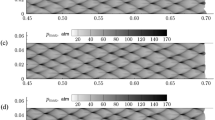Abstract
Heterogeneous detonations involving aluminium suspensions have been studied for many years for industrial safety policies, and for military and propulsion applications. Owing to their weak detonability and to the lack of available experimental results on the detonation cellular structure, numerical simulations provide a convenient way to improve the knowledge of such detonations. One major difficulty arising in numerical study of heterogeneous detonations involving suspensions of aluminium particles in oxidizing atmospheres is the modelling of aluminium combustion. Our previous two-step model provided results on the effect on the detonation cellular structure of particle diameter and characteristic chemical lengths. In this study, a hybrid model is incorporated in the numerical code EFAE, combining both kinetic and diffusion regimes in parallel. This more realistic model provides good agreement with the previous two-step model and confirms the correlations found between the detonation cell width, and particle diameter and characteristic lengths. Moreover, the linear dependence found between the detonation cell width and the induction length remains valid with the hybrid model.
Similar content being viewed by others
References
Zhang F., Grönig H., Van de Ven A.: DDT and detonation waves in dust–air mixtures. Shock Waves 11, 53–71 (2001)
Ingignoli, W., Veyssiere, B., Khasainov, B.A.: Shock initiation of detonations in aluminium–oxygen mixtures. In: Pulsed and Continuous Detonations, pp. 218–224. Torus Press, Moscow, ISBN 5-94588-040-X (2006)
Briand, A., Veyssiere, B., Khasainov, B.A.: Detonability of aluminium suspensions. In: Proceedings of the 7th ISHPMIE, vol. 2, pp. 213–222. St. Petersburg, Russia (2008)
Veyssiere B., Khasainov B.A., Briand A.: Investigation of detonation initiation in aluminium suspensions. Shock Waves 18(4), 307–315 (2008)
Benkiewicz K., Hayashi A.K.: Two-dimensional numerical simulations of multi-headed detonations in oxygen–aluminium mixtures using adaptative mesh refinement. Shock Waves 12(5), 385–402 (2003)
Fedorov A.V., Khmel T.A.: Numerical simulation of formation of cellular heterogeneous detonation of aluminium particles in oxygen. Comb. Expl. Shock Waves 41(4), 435–448 (2005)
Khmel T.A., Fedorov A.V.: Dependence of the heterogeneous detonation cell size on the flow scales. In: Roy, G., Frolov, S.M. (eds) Pulse and Continuous Detonation Propulsion, pp. 107–122. Torus Press, Moscow (2006)
Zhang, F., Gerrard, K.B., Ripley, R.C., Tanguay, V.: Unconfined aluminium particles–air detonation. In: Proceedings of the 26th ISSW, pp. 15–20. Goettingen, Germany (2007)
Khasainov B.A., Veyssiere B.: Analysis of the steady double-front detonation structure for a detonable gas laden with aluminium particles. Arch. Combust. 7(3–4), 333–352 (1987)
Zhang F., Murray S.B., Gerrard K.B.: Aluminium particles–air detonation at elevated pressure. Shock Waves 15, 313–324 (2006)
Shchelkin, K.I., Troshin, Ya.K.: Gas-Dynamics of Combustion [in Russian]. Izd. Akad. Nauk. SSSR, Moscow (1963)
Frank-Kamenetzkii D.A.: Diffusion and Heat Transfer in Chemical Kinetics. Plenum Press, New York (1969)
Nigmatulin R.I.: Prikl. Matemat. Mekh. 34, 1097–1112 (1970)
Veyssiere B., Khasainov B.A.: A model for steady, plane, double- front detonations (DFD) in gaseous explosive mixtures with aluminium particles in suspension. Combust. Flame 85, 241–253 (1991)
Price E.W.: Combustion of metalized propellants, fundamentals of solid propellant combustion. In: Kuo, K.K., Summerfield, M.M. (eds) Progress in Astronautics and Aeronautics, vol. 90, pp. 479–513. AIAA, New York (1984)
Veyssiere B., Kato Y., Brochet C., Bouriannes R., Manson N.: Pyrometric studies of Al combustion in the wake of two-phase detonations. Arch. Combust. 3(3), 151–160 (1983)
Oran E.S., Boris J.P.: Numerical Simulation of Reactive Flow, 2nd edn. Cambridge University Press, Cambridge (2001)
Hirsch C.: Numerical Computation of Internal and External Flows. Vol. 1: Fundamentals of Numerical Discretization. Wiley, New York (1988)
Veyssiere B., Bozier O., Khasainov B.A.: Effect of a suspension of magnesium particles on the detonation characteristics of methane-oxygene-nitrogen mixtures at elevated initial pressure. Shock waves 12, 27–233 (2002)
Victorov S.B., Gubin S.A.: A double-front structure of detonation wave as the result of phase transition. Shock Waves 15(2), 113–128 (2006)
Ingignoli, W.: Etude de la formation et de la propagation des detonations dans des suspensions de particules d’aluminium en atmosphere oxydante ou reactive. These de Docteur-Ingenieur, ENSMA, University of Poitiers, France (1999)
Merzhanov A.G., Grigor’jev Yu.M., Gal’Chenko Yu.A.: Aluminium ignition. Combust. Flame 29, 1–14 (1977)
Author information
Authors and Affiliations
Corresponding author
Additional information
Communicated by L. Bauwens.
Rights and permissions
About this article
Cite this article
Briand, A., Veyssiere, B. & Khasainov, B.A. Modelling of detonation cellular structure in aluminium suspensions. Shock Waves 20, 521–529 (2010). https://doi.org/10.1007/s00193-010-0288-5
Received:
Revised:
Accepted:
Published:
Issue Date:
DOI: https://doi.org/10.1007/s00193-010-0288-5



